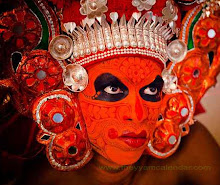



Teyyam is a magico-riligious observance. It is highly conditioned by myth. Such is the nature of theyyam and its powerful consequences. The very word teyyam brings forth in the mind of a listener an enchanting and beautiful picture. Nevertheless, in the case of the people of North Malabar, the word has more than one meaning . It is an indispensable part of their religion, and they observe it as their guide and protector. The believers who hold its ire bear woes and its blessing gifts for their well being. There are male and female teyyams. According to their nature, and myth in particular, it is possible to classify teyyams into different types namely, teyyams of God and Goddess, Ancestors, Heroes and Heroines, Spirits and Devils, and Nature or Animals. More details pls visit www.theyyamcalendar.com

No comments:
Post a Comment